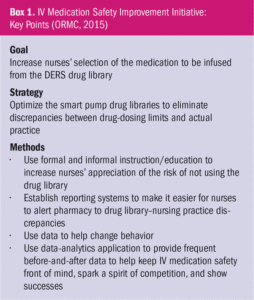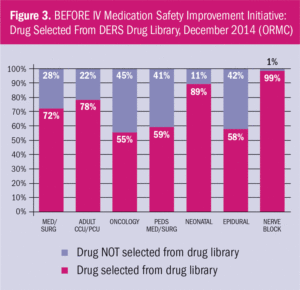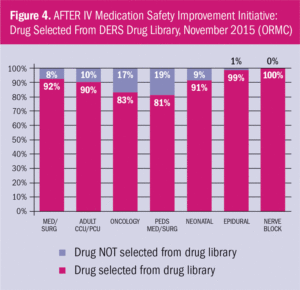Using Data Analytics to Change Behavior
Use data to help change behavior
The remotely hosted, advanced data-analytics application played a critical role in the IV Medication Safety Improvement Initiative (Box 1). The application reported DERS usage for each infusion, which made compliance with selecting the medication from the drug library easier to see and allowed the nursing staff to more easily monitor their performance. Authorized staff could access the smart pump data anywhere, anytime from an appropriate digital device. Retrospective data aggregated from the hospital’s smart pump system could be easily viewed on the application’s “dashboard” display.  Staff could easily review, report, create graphs and slides, and share important information with nursing directors, educators, senior management, and—most importantly—bedside clinicians.
Staff could easily review, report, create graphs and slides, and share important information with nursing directors, educators, senior management, and—most importantly—bedside clinicians.
Reporting DERS usage rates by unit was challenging, because the pumps were mobile and moved regularly around the hospital. However, rates could be tracked by patient profile. Medical/surgical nurses, for example, could easily see how they compared to critical care nurses. Having the nurses see the data on a regular basis also sparked a spirit of competition between departments, which further increased motivation and nursing engagement in the initiative.
Provide frequent, fresh communication
Report distribution started out weekly, then changed first to biweekly and later to monthly as nurses’ use of the DERS drug library began to increase (Table 1). At first, IV Safety Improvement bulletins were distributed to the chief nursing officer, nursing directors, and nursing educators, but not to individual nurses (who were already receiving a great deal of email). As awareness increased and nurses became more interested and involved, individuals were added to the email distribution list.
Continuously updating the before-and-after data kept the information fresh, kept nurses interested, showed their successes, and fostered a spirit of competition. As nurses saw improvements reflected in the changing data, they became increasingly involved in pharmacy-nursing collaboration (Box 2).
Results
IV medication safety improvements
Using data to help drive improvement resulted in steady increases in the use of the DERS drug library to select the medication to be infused (Figures 1, 3, and 4).
Other results
The IV Medication Safety Improvement Initiative also:
- Provided nursing and physician education regarding the importance of using DERS
- Provided a mechanism for nursing to inform pharmacy of any discrepancies between the drug library and actual practice
- Eliminated reported discrepancies between the drug library and actual practice
- Increased pharmacy-nursing collaboration
- Identified drug library entries that needed to be added or updated
- Increased nursing engagement
- Increased use of DERS safeguards by selecting the medication to be infused from the drug library
- Helped strengthen ORMC’s culture of safety
Recognition
Every year, ORMC departments can submit one or more projects for an enterprisewide quality and patient safety award. In 2015, the IV Safety Improvement initiative was awarded top honors at the GHVHS Quality and Patient Safety Awards, an important validation of the staff’s concerted, innovative efforts and results.
Next steps
Considerable progress has been made in putting DERS and continuous quality improvement at the forefront of medication safety awareness. Nonetheless, there is more work to be done. Pharmacy presentations at nursing education sessions and monthly reports on DERS usage continue. Multiple communication channels are still available. Email has emerged as the most commonly used means of communication.
In the future, staff will also analyze data on “good catches,” alerts, and overrides as another way to identify needed improvement in nursing practice and/or smart pump drug libraries. The smart pump data and remotely hosted data-analytics application can also be used to help staff demonstrate cost avoidance, return on investment achieved through a reduction in adverse drug events, and the hospital’s compliance with certain requirements of The Joint Commission. Finally, optimizing the drug libraries helps pave the way for future implementations of smart pump-EMR interoperability.
Lessons learned
Eliminating mismatches in the smart pump drug library helps drive use of DERS
Education, easy-to-use reporting systems, face-to-face discussions, and ongoing communication with frontline nursing are effective ways to educate the nursing staff and discover inadequacies in the drug library
Responding to nursing feedback in a timely manner keeps staff engaged
Frequent communication of data showing progress is essential
Data reports help celebrate nurse accomplishments and further strengthen nursing engagement in the IV medication safety improvement efforts
Conclusion
The ISMP points out that, like seat belts, the safety features of any safety technology can be bypassed, despite various mandates requiring their use. “Thus, it is not enough to purchase smart pumps, program the library to enable the technology, distribute the pumps, educate users, and hope that the dose-checking feature will always be used. A culture of safety must exist that drives clinicians to avoid bypassing such a safety feature, or to report conditions that encourage workarounds so they can be remedied” (ISMP, 2007).
At ORMC, before-and-after data from the analytics reports provided “something new” that helped to increase staff awareness of the need to always select the medication to be infused from the DERS drug library, motivate staff to report conditions that could encourage workarounds, and increases nurses’ engagement in the medication safety improvement process. Nurses continue to work with pharmacy to keep the drug library up to date. They know that their feedback is important and have become increasingly engaged in the compliance-improvement process. They recognize more fully that smart pump safety features can save lives and have to be used. Continuously fine-tuning the drug library in the continuing quality loop helps ensure that bedside clinicians have the latest data set for the safest clinical practice—and that the right thing to do is the easy thing to do.
Note: We would like to express our appreciation to BD and Sally Graver for helping to ensure accuracy and completeness during manuscript development.
Footnotes:
- a. Alaris System, with Guardrails Suite MX software, BD. Franklin Lakes, NJ.
- b. Knowledge Portal for Infuse on Technologies, BD. Franklin Lakes, NJ.
Nicole Karchner, PharmD, was the clinical pharmacy manager at Orange Regional Medical Center in Middletown, New York from 2009 to 2016. She is now the director of pharmacy management for Crystal Run Health Plans. She can be contacted at ekarchner@crystalrunhp.com.
REFERENCES
American Society of Health-System Pharmacists. (2008). Proceedings of a summit on preventing patient harm and death from IV medication errors. Am J Health-Syst Pharm, 65(24), 2367–2379.
Fields, M., & Peterman, J. (2005). Intravenous medication safety system averts high-risk medication errors and provides actionable data. Nurs Admin Quar, 29(1), 78–87.
Institute for Safe Medication Practices. (2007, April 19). Smart pumps are not smart on their own. ISMP Medication Safety Alert! Retrieved March 2, 2017 from http://www.ismp.org/newsletters/acutecare/articles/20070419.asp.
Maddox, R., Danello, S., Williams, G. K., & Fields, M. (2008). Intravenous infusion safety initiative: Collaboration, evidence-based best practices, and “smart” technology help avert high-risk adverse drug events and improve patient outcomes. In K. Henriksen, J. B. Battles, M. A. Keyes, & M. L. Grady (Eds.), Advances in Patient Safety: New Directions and Alternative Approaches, Vol. 4 (pp. 143–156). Rockville, MD: Agency for Healthcare Research and Quality.
The National Institute for Occupational Safety and Health (NIOSH). (2016, July 16). Hierarchy of Controls. Retrieved March 2, 2017 from https://www.cdc.gov/niosh/topics/hierarchy/default.html.
Orange Regional Medical Center (ORMC). (2015). IV Medication Safety Improvement Initiative, data on file.
Williams, C. K., & Maddox, R.R. (2005). Implementation of an I.V. medication safety system. Am J Health-Syst Pharm, 62(5), 530–536.
Wilson, K., & Sullivan, M. (2004). Preventing medication errors with smart infusion technology. Am J Health-Syst Pharm, 61(2), 177–183.


